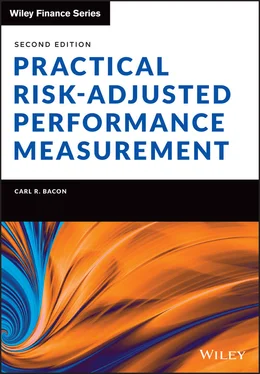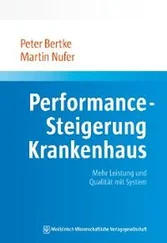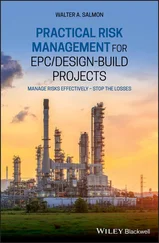Chapters 12 – 16 are entirely new chapters for this edition. Chapter 12 was really inspired by the background research and writing of the first edition. I wanted to classify all the ex-post risk measures and describe how they are linked; my thoughts came together too late to include the best presentation of this linkage in the first edition, which is, of course, a periodic table of risk measures. Chapter 13 discusses the use of risk-adjusted performance measures in the context of performance fees. Chapter 14 discusses dashboard design in the context of risk measures, Chapter 15 looks at the important subject of how appraisal measures should be used in the context of manager selection and Chapter 16 introduces the four dimensions of performance and makes the call for ex-ante risk standards.
In the penultimate Chapter 17 there is a discussion about which risk measures to use and finally Chapter 18 reviews their application in terms of risk control.
The objective of this edition remains to provide a complete list of ex-post risk measures used by asset managers. Although some have little merit, I've avoided censoring measures I dislike. If a risk measure is not included, maybe I don't fully understand it with enough confidence to write about it, or in a few rare cases I've determined that it literally has no merit.
1 1The misuse of mathematics in order to mislead; see Paul Romer (2015) Mathiness in the Theory of Economic Growth. American Economic Review 105, 89–93.
My thanks are owed to many who have contributed to this book, both directly and indirectly – working colleagues over many years, attendees at my various training courses and workshops which I hope will continue, attentive readers of my previous books who have spotted a number of errors and indeed made many good suggestions, numerous fellow GIPS ®committee members who have been so insightful and of course the many authors who have laid the foundations of this subject.
I'm particularly thankful to the diligent reviewers of this book, in particular Damian Handzy, Neil Riddles, Paul Giles and Joe Kavanagh for their numerous detailed comments and suggestions; this book is much better for their contribution. Of course, all errors and omissions are my own.
Carl R. Bacon CIPM
Deeping St James
August 2021
carlrbacon@icloud.com
About the Companion Website
This book is accompanied by a companion website: www.wiley.com\go\bacon\riskadjustedperformance2e
The website includes:
Excel spreadsheet with supporting data and underlying calculations for all exhibits
The Periodic Table of Risk Measures
“Money is like muck, not good except it be spread.”
Francis Bacon (1561–1626)
Risk means very different things to different audiences at different times; risk is truly in the eye of the beholder. In the context of asset management, the Oxford English Dictionary provides a surprisingly good definition of risk:
The potential impact of an event determined by combining the likelihood of the event occurring with the impact should it occur.
Risk is the combination of exposure and uncertainty. As Holton 1 (2004) so eloquently points out it is not risky to jump out of an aircraft without a parachute because death is certain. Holton also points out that we can never operationally define risk; at best, we can operationally define our perception of risk.
Another common and effective, but broader definition of risk is exposure to uncertainty.
Within asset management firms there are many types of risk that should concern asset managers and senior management. For convenience I've chosen to classify risk into five main categories:
Compliance Risk
Operational Risk
Liquidity Risk
Counterparty Risk
Portfolio Risk
These risks are ranked in my priority order of concern at the point in time I assumed the role of Director of Risk Control at an asset management firm in the late 1990s. 2 What I didn't appreciate fully then, but appreciated much later, is that priorities will vary through time; during the credit crisis I'm sure counterparty risk became the number one priority for many firms.
Although a major concern of all asset managers, reputational risk does not warrant a separate category; a risk failure in any category can cause significant damage to a firm's reputation.
Compliance or regulatory risk is the risk of breaching a regulatory, client or internally imposed guideline, restriction or clear limit. I draw no distinction between internal or external limits; the breach of an internal limit indicates a control failure, which could just as easily have been a regulatory, or client mandated limit. Of course, the financial impact of breaching limits can be significant; in August 1996 Peter Young of Morgan Grenfell Asset Management allegedly cost Deutsche Bank £300 to £400 million in compensation payments to investors in highly regulated authorised unit trusts. Peter Young used Luxembourg listed shell companies to circumvent limits on unlisted and risky holdings.
Operational risk, often defined as a residual catch-all category to include risks not defined elsewhere, actually includes the risk of human error, fraud, system failure, poor controls, management failure and failed trades. Risks of this type are more common but usually less severe. Nevertheless, it is important to continuously monitor errors and near misses of all types, even those that do not result in financial loss. An increase in the frequency of errors regardless of size or sign may indicate a more serious problem that requires further investigation and corrective action. Although typically small in size, operational errors can lead to large losses. In December 2005 a trader at the Japanese brokerage firm Mizuho Securities made a typing error and tried to sell 610,000 shares at 1 yen apiece in recruiting company J-Com Co., which was debuting on the exchange, instead of an intended sale of one share at ¥610,000 – an example of fat-finger syndrome. Mizuho lost approximately ¥41 billion. In April 2007, 3 a programmer at AXA Rosenberg incorrectly programmed a statistical model, leading to $217 million in losses for clients. A Securities and Exchange Commission (SEC) investigation found that senior management learned in June 2009 of a material error, but instead of disclosing and fixing the error a senior official directed others to keep quiet. The error was kept from senior management until November 2009 and from clients until April 2010. According to the SEC, the firm failed to disclose the error and its impact on client performance, attributed the model's underperformance to market volatility and misrepresented the model's ability to control risk. AXA Rosenberg paid an additional $25 million penalty fine.
Liquidity risk is the risk that assets cannot be traded quickly enough in a market to change asset and risk allocations, realise profits or prevent losses. Perhaps liquidity risk has received less attention than it should in the past but it is capable of causing significant damage. The demise of Long Term Capital Management (LCTM) 4 in 1998 was really a liquidity issue compounded by massive leverage. In less than one year LTCM lost $4.4 billion of its $4.7 billion capital. LTCM was a hedge fund based in Greenwich, Connecticut that used absolute return strategies combined with high leverage. LTCM had been making losses throughout the summer of 1998 which were further compounded by the Russian Debt Crisis in August and September causing a flight to quality. This resulted in the bidding up of the price of the most liquid securities in which LTCM was short and depressing the price of less liquid securities of which LTCM was long. As rumours of LTCM's positions spread, market participants positioned themselves for forced liquidation; eventually LTCM was forced to liquidate at exactly the wrong time, increasing its losses.
Читать дальше










